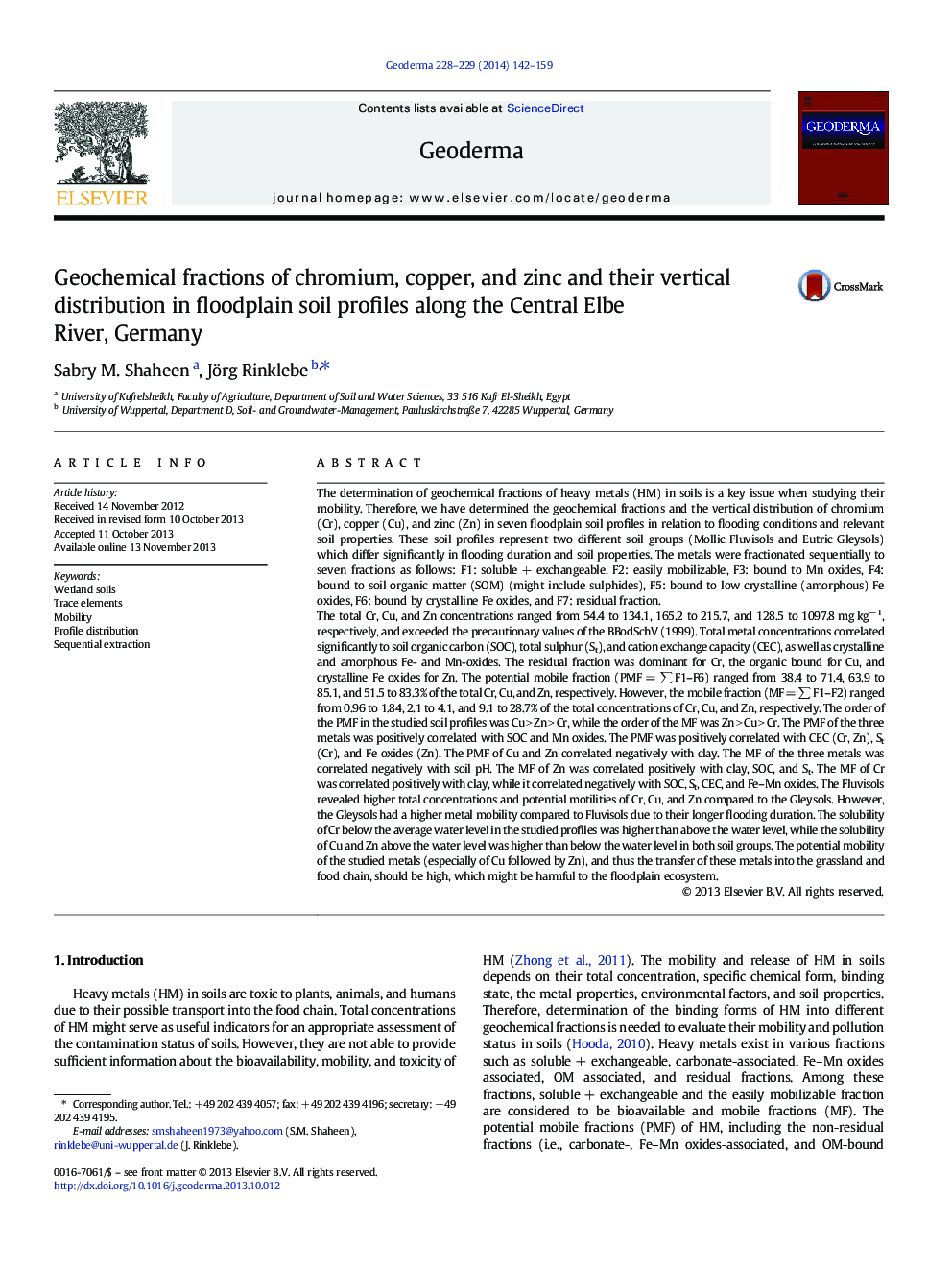| کد مقاله | کد نشریه | سال انتشار | مقاله انگلیسی | نسخه تمام متن |
|---|---|---|---|---|
| 4573361 | 1629471 | 2014 | 18 صفحه PDF | دانلود رایگان |
• Geochemical fractions of Cr, Cu, and Zn in floodplain soil profiles were determined.
• Total metal concentrations exceeded frequently the precautionary values.
• Long term flooded soils (Gleysols) show a higher metal mobility than Fluvisols.
• The order of potential mobile fraction (PMF) was: Cu > Zn > Cr.
• The order of the mobile fraction (MF) was: Zn > Cu > Cr.
The determination of geochemical fractions of heavy metals (HM) in soils is a key issue when studying their mobility. Therefore, we have determined the geochemical fractions and the vertical distribution of chromium (Cr), copper (Cu), and zinc (Zn) in seven floodplain soil profiles in relation to flooding conditions and relevant soil properties. These soil profiles represent two different soil groups (Mollic Fluvisols and Eutric Gleysols) which differ significantly in flooding duration and soil properties. The metals were fractionated sequentially to seven fractions as follows: F1: soluble + exchangeable, F2: easily mobilizable, F3: bound to Mn oxides, F4: bound to soil organic matter (SOM) (might include sulphides), F5: bound to low crystalline (amorphous) Fe oxides, F6: bound by crystalline Fe oxides, and F7: residual fraction.The total Cr, Cu, and Zn concentrations ranged from 54.4 to 134.1, 165.2 to 215.7, and 128.5 to 1097.8 mg kg− 1, respectively, and exceeded the precautionary values of the BBodSchV (1999). Total metal concentrations correlated significantly to soil organic carbon (SOC), total sulphur (St), and cation exchange capacity (CEC), as well as crystalline and amorphous Fe- and Mn-oxides. The residual fraction was dominant for Cr, the organic bound for Cu, and crystalline Fe oxides for Zn. The potential mobile fraction (PMF = ∑ F1–F6) ranged from 38.4 to 71.4, 63.9 to 85.1, and 51.5 to 83.3% of the total Cr, Cu, and Zn, respectively. However, the mobile fraction (MF = ∑ F1–F2) ranged from 0.96 to 1.84, 2.1 to 4.1, and 9.1 to 28.7% of the total concentrations of Cr, Cu, and Zn, respectively. The order of the PMF in the studied soil profiles was Cu > Zn > Cr, while the order of the MF was Zn > Cu > Cr. The PMF of the three metals was positively correlated with SOC and Mn oxides. The PMF was positively correlated with CEC (Cr, Zn), St (Cr), and Fe oxides (Zn). The PMF of Cu and Zn correlated negatively with clay. The MF of the three metals was correlated negatively with soil pH. The MF of Zn was correlated positively with clay, SOC, and St. The MF of Cr was correlated positively with clay, while it correlated negatively with SOC, St, CEC, and Fe–Mn oxides. The Fluvisols revealed higher total concentrations and potential motilities of Cr, Cu, and Zn compared to the Gleysols. However, the Gleysols had a higher metal mobility compared to Fluvisols due to their longer flooding duration. The solubility of Cr below the average water level in the studied profiles was higher than above the water level, while the solubility of Cu and Zn above the water level was higher than below the water level in both soil groups. The potential mobility of the studied metals (especially of Cu followed by Zn), and thus the transfer of these metals into the grassland and food chain, should be high, which might be harmful to the floodplain ecosystem.
Journal: Geoderma - Volumes 228–229, September 2014, Pages 142–159
